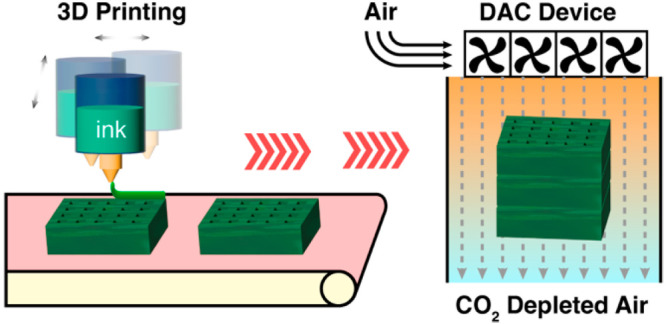- Record: found
- Abstract: found
- Article: found
Cold Temperature Direct Air CO 2 Capture with Amine-Loaded Metal–Organic Framework Monoliths

Read this article at
Abstract

Zeolites, silica-supported amines, and metal–organic frameworks (MOFs) have been demonstrated as promising adsorbents for direct air CO 2 capture (DAC), but the shaping and structuring of these materials into sorbent modules for practical processes have been inadequately investigated compared to the extensive research on powder materials. Furthermore, there have been relatively few studies reporting the DAC performance of sorbent contactors under cold, subambient conditions (temperatures below 20 °C). In this work, we demonstrate the successful fabrication of adsorbent monoliths composed of cellulose acetate (CA) and adsorbent particles such as zeolite 13X and MOF MIL-101(Cr) by a 3D printing technique: solution-based additive manufacturing (SBAM). These monoliths feature interpenetrated macroporous polymeric frameworks in which microcrystals of zeolite 13X or MIL-101(Cr) are evenly distributed, highlighting the versatility of SBAM in fabricating monoliths containing sorbents with different particle sizes and density. Branched poly(ethylenimine) (PEI) is successfully loaded into the CA/MIL-101(Cr) monoliths to impart CO 2 uptakes of 1.05 mmol g monolith –1 at −20 °C and 400 ppm of CO 2. Kinetic analysis shows that the CO 2 sorption kinetics of PEI-loaded MIL-101(Cr) sorbents are not compromised in the monoliths compared to the powder sorbents. Importantly, these monoliths exhibit promising working capacities (0.95 mmol g monolith –1) over 14 temperature swing cycles with a moderate regeneration temperature of 60 °C. Dynamic breakthrough experiments at 25 °C under dry conditions reveal a CO 2 uptake capacity of 0.60 mmol g monolith –1, which further increases to 1.05 and 1.43 mmol g monolith –1 at −20 °C under dry and humid (70% relative humidity) conditions, respectively. Our work showcases the successful implementation of SBAM in making DAC sorbent monoliths with notable CO 2 capture performance over a wide range of sorption temperatures, suggesting that SBAM can enable the preparation of efficient sorbent contactors in various form factors for other important chemical separations.
Related collections
Most cited references51
- Record: found
- Abstract: found
- Article: not found
Immobilizing highly catalytically active Pt nanoparticles inside the pores of metal-organic framework: a double solvents approach.
- Record: found
- Abstract: not found
- Article: not found